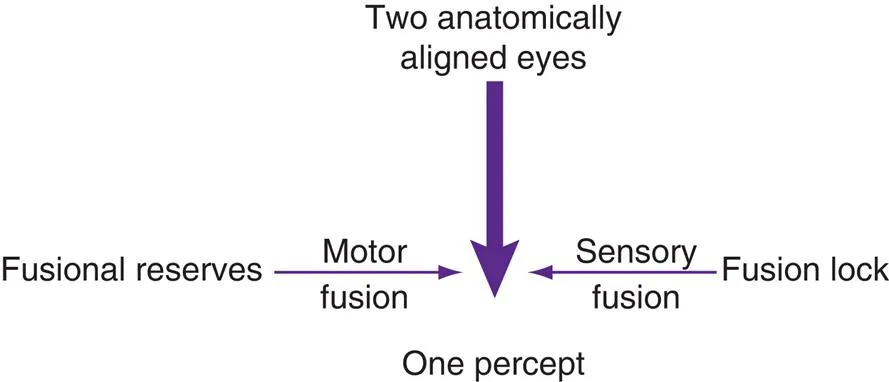
- 464 pages
- English
- ePUB (mobile friendly)
- Available on iOS & Android
Pickwell's Binocular Vision Anomalies E-Book
About this book
Now in a fully up-to-date 6th Edition, Pickwell's Binocular Vision Anomalies provides a practical introduction to binocular vision, offering comprehensive theory, how-to clinical guidance, and a summary of current research in a single, consolidated volume. Ideally suited for both students and clinicians, this bestselling text serves as an accessible, evidence-based reference when faced with binocular vision or pediatric challenges.- Covers routine examinations and testing protocols, including CISS questionnaire, cover test, foveal suppression, fixation disparity, four prism diopter base out test, Lindblom's method, and double Maddox rod test.- Includes numerous video clips of key testing procedures, including new clips on Mallett fixation disparity test and fusional reserve testing, as well as an interactive video quiz to help you test your knowledge.- Features sweeping content updates such as the latest information on 3-D displays, therapeutic uses of computer games and virtual reality for vision therapy, computerized testing methodologies, binocular and accommodative mechanisms associated with myopia, updated prescribing criteria, therapeutic use of contact lenses, detection of pathology associated with strabismus, drugs causing diplopia, and the evidence-based treatment of convergence insufficiency syndrome and amblyopia.- Contains helpful study features throughout, including Clinical Key Points boxes, step-by-step test routines, typical features of extraocular muscle palsies and syndromes, and Case Study boxes that cover important clinical and legal scenarios, and new boxes that summarize testing procedures for each of the main binocular vision tests.- Enhanced eBook version included with purchase. Your enhanced eBook allows you to access all of the text, figures, and references from the book on a variety of devices.
Frequently asked questions
- Essential is ideal for learners and professionals who enjoy exploring a wide range of subjects. Access the Essential Library with 800,000+ trusted titles and best-sellers across business, personal growth, and the humanities. Includes unlimited reading time and Standard Read Aloud voice.
- Complete: Perfect for advanced learners and researchers needing full, unrestricted access. Unlock 1.4M+ books across hundreds of subjects, including academic and specialized titles. The Complete Plan also includes advanced features like Premium Read Aloud and Research Assistant.
Please note we cannot support devices running on iOS 13 and Android 7 or earlier. Learn more about using the app.
Information
Nature of Binocular Vision Anomalies
Abstract
Keywords
Introduction
- 1. The anatomy of the visual apparatus.
- 2. The motor system that coordinates movement of the eyes.
- 3. The sensory system through which the brain receives and integrates the two monocular signals.
- 1. Anatomy. Abnormalities in the anatomy of the visual system can be either developmental, occurring in the embryological development of the bony orbit, ocular muscles, or nervous system, or acquired through accident or disease.
- 2. Motor system. Even if the motor system is anatomically normal, anomalies can occur in the functioning which can disturb binocular vision or cause it to break down. These may be due to disease, or they may be malfunctions of the physiology of the motor system. For example, excessive accommodation due to uncorrected hypermetropia can result in excessive convergence due to the accommodation–convergence relationship. This is a frequent cause of binocular vision problems. Examples of disease affecting the motor system are haemorrhages involving the nerve supply to the extraocular muscles, changes in intracranial pressure near the nerve nuclei, or pressure on the nerves or nerve centres from abnormal growths of intracranial tissue. Such conditions require urgent medical attention to the primary condition and early recognition is therefore essential. The investigation for this type of pathology is discussed in Chapter 17.
- 3. Sensory system. Anomalies in the sensory system can be caused by such factors as a loss of clarity of the optical image in one or both eyes, an image larger in one eye than the other (aniseikonia), anomalies of the visual pathway or cortex, or central factors in the integrating mechanism. The ultimate goal of binocularity is stereopsis (DeAngelis, 2000), which improves motor skills at near distances (O'Connor, Birch, Anderson, & Draper, 2010), but has a minimal effect beyond about 40 m (Bauer, Dietz, Kolling, Hart, & Schiefer, 2001).
Stereopsis is not the only benefit from binocularity: there is a binocular advantage in terms of visual acuity and contrast sensitivity. The benefit in terms of contrast sensitivity is underestimated in the ideal conditions of visual acuity testing. For example, when driving in snow or with a dirty windshield, binocularity markedly outperforms monocular vision (Otto, Bach, & Kommerell, 2010). Binocular performance is better than monocular at a wide range of tasks (Sheedy, Bailey, Buri, & Bass, 1986). Difficulties in the coordinating mechanism of the motor system can also be accompanied by adaptations and anomalies in the sensory system, such as suppression, abnormal retinal correspondence, or amblyopia. These may occur to lessen the symptoms caused by the motor anomaly, as adaptations of the sensory system.


1, Anatomical position of rest; 2, physiological position of rest (passive position); 3, position of functional rest; 4, active position for distance vision or primary position; 5, active position for near vision; A, tonus; B, initial convergence; C, fusional vergence; D, the sum of accommodative convergence, proximal vergence and fusional vergence for near vision. (Modified from Solomons, 1978, Binocular Vision: a Programmed Text, Heinemann, London.).
Table of contents
- Cover image
- Title page
- Table of Contents
- Copyright
- Preface
- Preface to First Edition
- Part 1: Investigation
- Part 2: Heterophoria
- Part 3: Strabismus
- Part 4: Incomitant Deviations and Nystagmus
- References
- Glossary
- Appendices
- Index